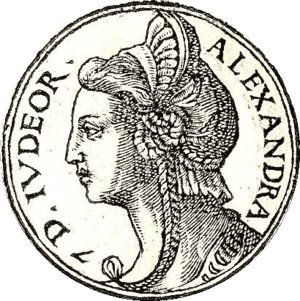Salome Alexandra facts for kids
Quick facts for kids Salome Alexandra |
|
|---|---|

Salome Alexandra, from Guillaume Rouillé's Promptuarii Iconum Insigniorum
|
|
| Queen of Judaea | |
| Reign | c. 76 – 67 BCE |
| Predecessor | Alexander Jannaeus |
| Successor | Hyrcanus II |
| Spouse | Aristobulus I (c. 104–103 BCE), Alexander Jannaeus (c. 103 – 76 BCE), then widow after. |
| Issue | Hyrcanus II Aristobulus II |
| Father | Shetah (disputed) |
| Religion | Judaism |
Salome Alexandra, also known as Shlomtzion (141–67 BCE), was a powerful queen who ruled over Judea. She was one of only two women to lead this ancient kingdom. Salome Alexandra was first married to Aristobulus I. After he died, she married his half-brother, Alexander Jannaeus. She was the last queen to rule Judea as an independent kingdom.
Contents
Family and Early Life
Historians don't know much about Salome Alexandra's early family. Some Jewish writings say her brother was a famous rabbi named Simeon ben Shetah. This would mean her father was Shetah.
Salome Alexandra had two sons with Alexander Jannaeus. Her older son was Hyrcanus II. Her younger son was Aristobulus II. Later, these two brothers fought over who would be the Jewish High Priest. Hyrcanus II eventually won with help from other leaders.
Becoming Queen
When her first husband, Aristobulus I, died, Salome Alexandra helped free his half-brother, Alexander Jannaeus, from prison. Alexander then became king and married Salome Alexandra.
During Alexander's rule, Salome Alexandra didn't have much political power. Her husband, King Alexander, often disagreed with a group called the Pharisees. However, Salome Alexandra was known to protect the Pharisees. She even hid them from her husband's anger.
Before he died, King Alexander Jannaeus trusted Salome Alexandra to rule the kingdom. He told her to make peace with the Pharisees. This was a very important task for her.
Leading the Kingdom
After Alexander's death in 76 or 75 BCE, Salome Alexandra became queen. She kept his death a secret until a fortress they were attacking had fallen. This helped her maintain control.
She was very good at calming down the arguments within the kingdom. She did this peacefully. She also made sure Judea had good relationships with other countries. The Pharisees had suffered under King Alexander. Queen Salome Alexandra managed to get their support for her rule.
Rebuilding the Sanhedrin
Under Queen Salome Alexandra, the Pharisees became very important. They were no longer just a group; they became the ruling class. She made her oldest son, Hyrcanus II, the High Priest. He supported the Pharisees completely.
The Sanhedrin was like a supreme court for justice and religious matters. Queen Salome Alexandra reorganized it. The Pharisees were put in charge of guiding its decisions.
Protecting the Kingdom
Another group, the Sadducees, asked the queen for protection. Salome Alexandra wanted to avoid arguments between groups. She moved the Sadducees out of Jerusalem. She gave them certain strong towns to live in.
Queen Salome Alexandra also made the army bigger. She made sure that many fortified towns had plenty of supplies. These towns and castles were along the borders of Judea. Other kings were impressed by how strong Judea looked.
She also sent her son Aristobulus II with an army to attack Damascus. This expedition didn't achieve much.
Towards the end of her rule, her son Aristobulus tried to take over the government. He succeeded her after she died.
A Time of Plenty
Jewish writings describe a time of great wealth and happiness in Judea under Salome Alexandra. They say that because she was so religious, rain only fell on Friday nights. This meant workers didn't lose pay because of rain during the week.
The land was so fertile that wheat grains grew as big as kidney beans! Oats were as large as olives. Lentils were as big as gold coins. Wise people saved examples of these huge grains. They wanted to show future generations what good things could happen when people followed the Law.
Her Name Today
The name "Shlomtzion" is still used today in Israel as a girl's first name. For example, the writer Amos Kenan named his daughter Shlomtzion.
In Jerusalem, there's a main street called "Queen Shlomzion Street." It was named after her to remember this important Jewish queen. There are also streets with her name in other Israeli cities like Tel Aviv and Ramat Gan.
In 1977, a new political party was formed in Israel. Its leader, Ariel Sharon, named it "Shlomtzion."
Even leopards in the Judean Desert have been named Shlomtzion! Zoologists named a female leopard "Shlomtzion" because they studied her life and family for many years.
See also
 In Spanish: Salomé Alejandra para niños
In Spanish: Salomé Alejandra para niños


